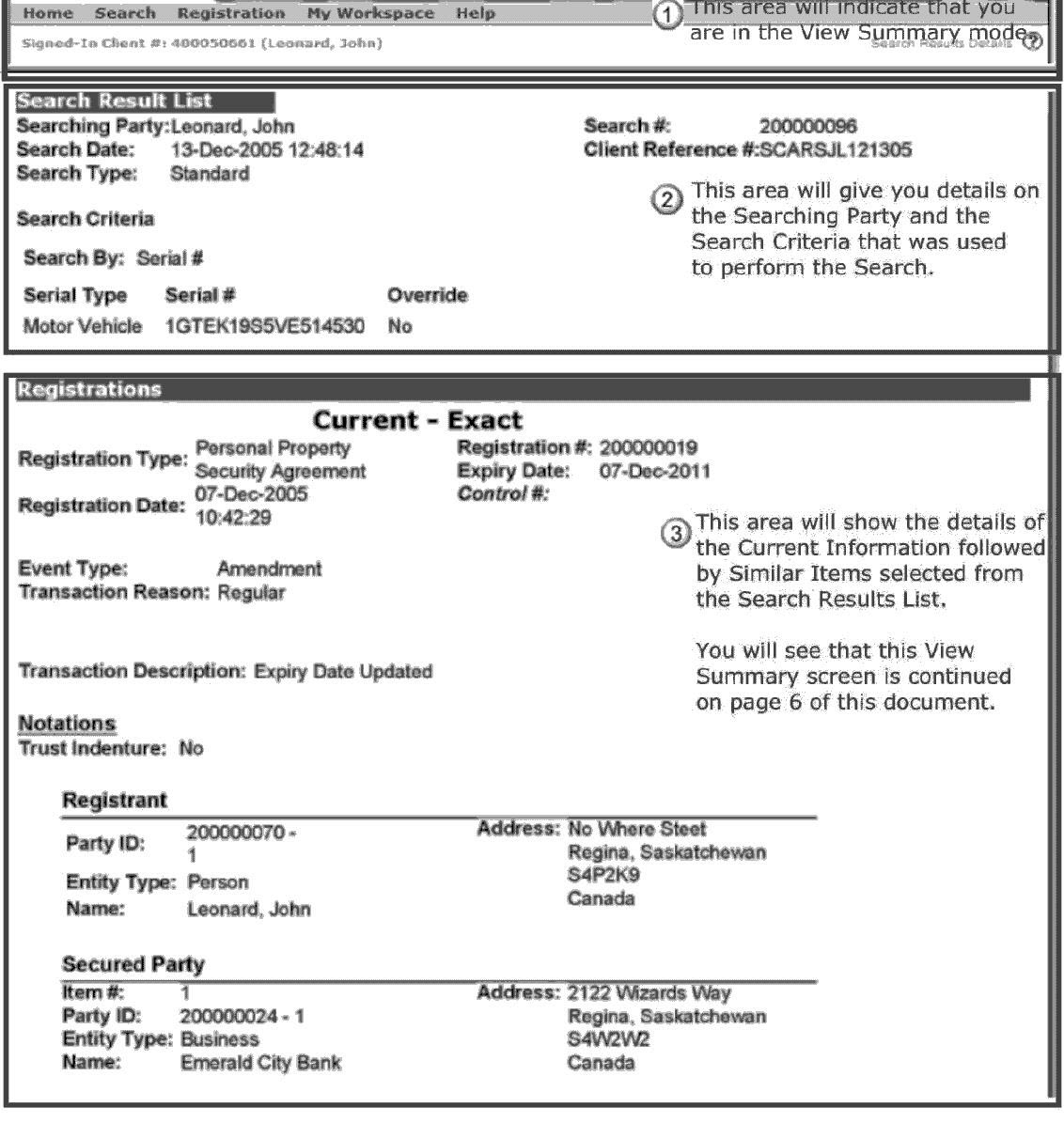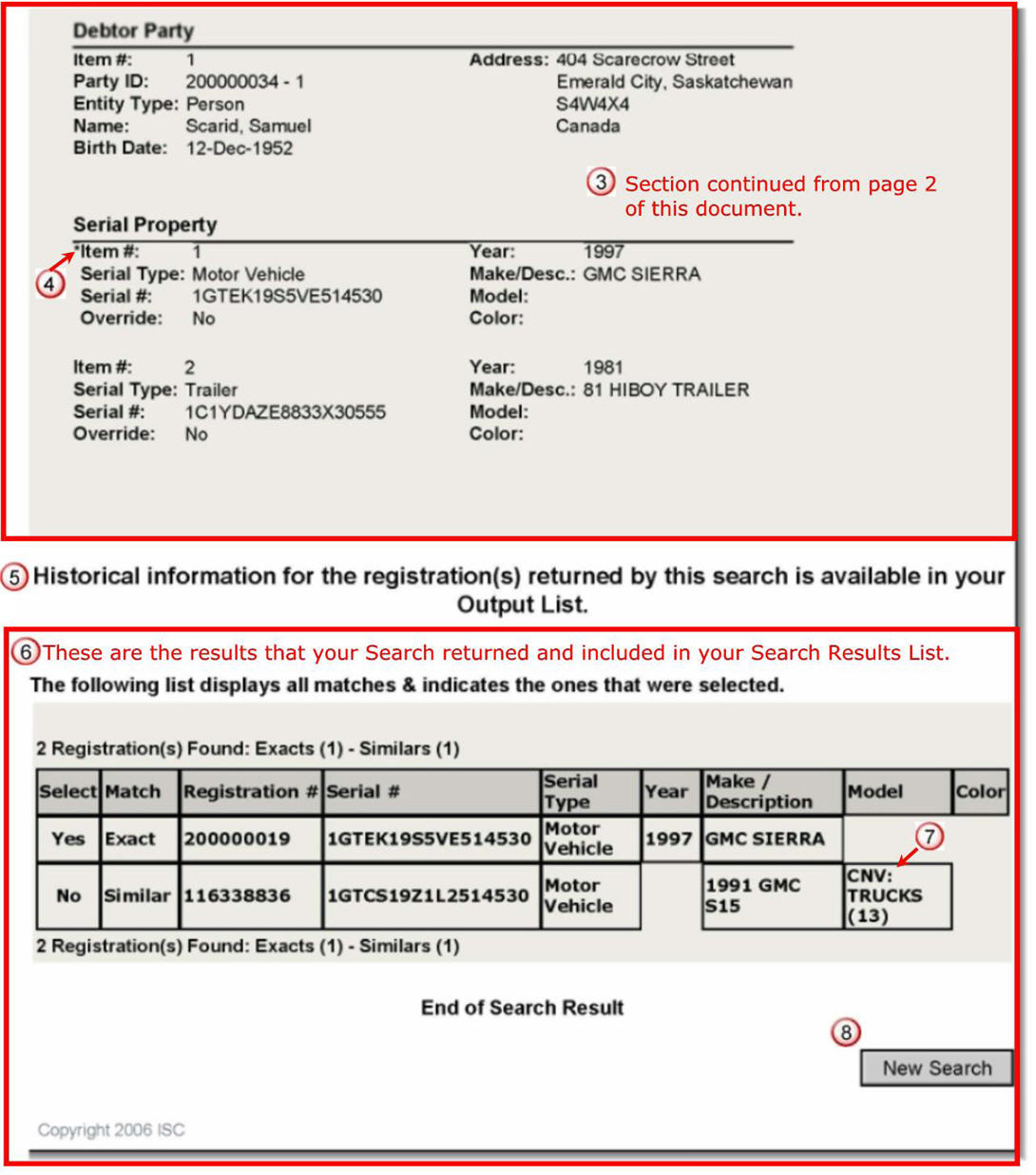The View Summary displays the Current Information of the Registration(s) you selected.
It is important that you know that the key difference between the View Summary Web Page and the Output Search Results Report is that the View Summary only displays Current Information.
The Search Results Report provides both Current and History Information (if any) on a Registration. History information includes any Amendments that occurred since the original Setup.
The top section of the page, repeats the information that was provided to you in Step 3 of the search process. It displays the name of the searching party, the search type, the search criteria, the date and time of the search along with the unique Search Number. The first page of the report will indicate whether the search was clear of liens or exact/similar matches exist.
The remainder of the report provides information about the details if lien(s) exist. Exact matches are automatically included in the report and only the details of similar that were selected will be included in the report. The report will provide a current page followed by historical information on how it got to the current state.
The registrant party is the one who registered the lien.
The secured/creditor party is the one that is owed money by the debtor.
The debtor party is the one that owes money to the secured/creditor party.
The serial and/or general property is the collateral that the secured/creditor party has an interest in.
NOTE: You will need to contact the secured/creditor party to find out how much of the lien is still outstanding.
Results:
If you have obtain a result indicating "There are no registration(s) found in the SPPR to match the search criteria." This means the search has no liens based on the criteria entered. Remember to print your results as you will want a copy of this result indicating the date and time of your search.
If you have obtain results indicating exact matches this means their is an active lien based on your search criteria. Contact the secured/creditor party to find out how much is still outstanding.
If you selected any similar matches including them in the detail report, contact the secured/creditor party to find out how much is still outstanding. Similar matches are returned based on a coding routine indicating the debtor or serial number was close to the searching criteria.

1. The View Summary displays the Current Information of the Registration(s) you selected from the Search Result List.
- Because you are working online you can continue to access the other areas of the SPPR Application because it’s still a web page.
- In our example we saved the web page to a .pdf file so we could include the entire page in the learning manual. It looks a little different here, however the information, layout and fields are all the same.
2. Search Result List – This area gives you detailed information on who performed the Search, and the Search Criteria that was used.
- Search #: It’s a good idea to record this number for your records. Each Search that is performed is given a unique Search Number and displayed here. The Search # will appear on the Statement of Account.
- Client Reference #: Remember how we told you in the Performing a Search module that the Client Reference # was a very useful field. This is your reference number that you entered when you are performing your search.
3. Registrations – The View Summary option provides you with the details of Current Information followed by any Similars they selected on the Search Results List page. The top portion of this section provides you with details on the Registration.
- Registration Type: In this example the Registration Type is a Personal Property Security Agreement. Some other of the more common ones are Personal Property Sale of Goods, or Commercial Lien.
- Registration Date: This is the date and time of the original Registration.
- Registration #: This is the # that is automatically assigned to the request by the SPPR Application. You should make sure you record it for your records.
- Expiry Date: This is the expiry date of the original Registration. It is important that these dates are diarized by the Registrant. We will not notify anyone if a Registration is about to expire.
- Control #: The Control number is used at ISC to track all requests. It will appear in this area when an Internal ISC employee is performing a Search. However, the field will be blank for external customers.
- Event Type: This will show the action that was initiated regarding the Registration. For example; Setup, Amendment or Discharge.
- Transaction Reason: This is where you can choose a reason why the Registration is being amended from a drop down menu. Our example shows Transaction Reason: Regular (Another example could be because of SPPR Error Correction.)
- Transaction Description: This is a useful field because it can be used to describe in more detail why the Registration is being amended.
- Trust Indenture: This area is only applicable to Personal Property Security Agreements (PPSA).
- The area that follows this information provides you with details on the Registrant, Secured Party, Debtor Party, Serial Property and General Property.

4. The * indicates that this is one of the items you selected from the Search Results List or it matched the criteria that was entered.
5. This comment is self-explanatory but a great reminder that if you are interested in the history of a Registration you will have to go to your Output List and look at your Search Results Report.
6. These are items that we listed in your Search Results List. It indicates which ones were selected and which ones were not.
7. CNV: This indicates that this Registration went through the Conversion Process. What this means is that all Registrations in the current database must go through a conversion in order to capture the information under the correct tabs in the correct fields within the new SPPR Application. ISC is required to display this information because a Registration is a legal document and we want to make sure everything is cross-reference from the old world to the new. Let’s take a look at our example, it reads; CNV: Trucks (13)
- The CNV shows that the Registration went through the Conversion Process. In our previous system we used codes when registering Serial Type Property and TRUCKS were a code 13.
- In the new SPPR Application the code Trucks (13) is now Motor Vehicle (remember Motor Vehicle is the default in the Serial Type pull-down).
8. When you are viewing your summary results you are really just viewing the current information only of your results on a web page. The keyword here is web page ~ you are one mouse click away from performing a brand new search if you wish.
Remember